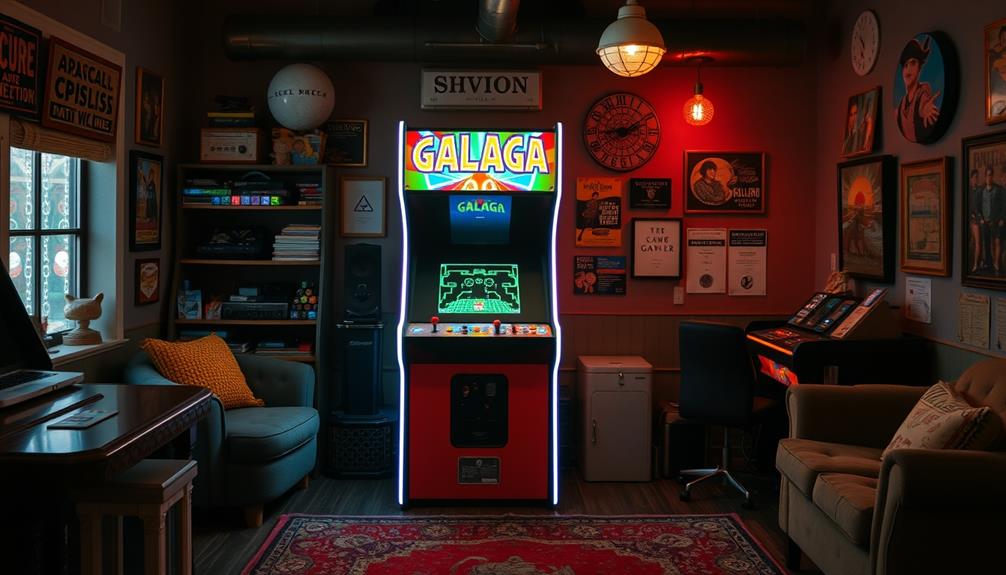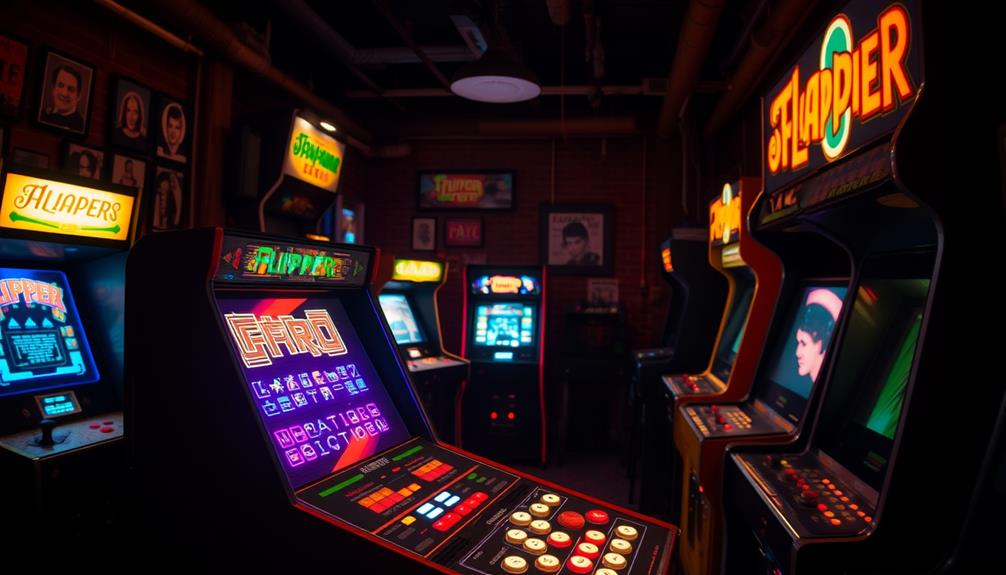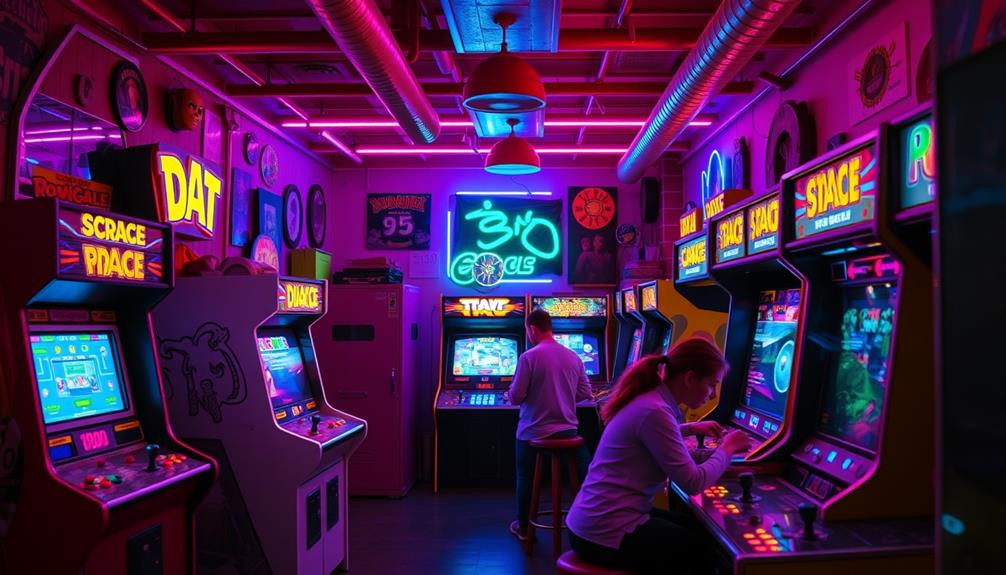When considering well-known arcade games, iconic titles such as Pac-Man, Space Invaders, and Street Fighter II immediately come to mind. Pac-Man, a symbol of culture, was incredibly successful, selling millions of cabinets. Space Invaders was a trailblazer in the shooter genre and also brought in substantial profits. Street Fighter II played a crucial role in the development of competitive gaming with its memorable characters and engaging gameplay. Donkey Kong introduced the world to Mario, while Mortal Kombat II pushed boundaries with its graphic violence. These games not only influenced arcade culture but also have had a long-lasting impact on gaming today. There is still so much more to learn about these legendary games and their legacy.
Key Takeaways
- Pac-Man (1980) is a cultural icon, selling 400,000 cabinets and generating $3.5 billion by 1990.
- Space Invaders (1978) pioneered the shooter genre, selling 750,000 cabinets and earning $7.6 billion by 1982.
- Street Fighter II (1991) established competitive fighting culture, with 320,000 cabinets sold and $8.5 billion earned.
- Donkey Kong (1981) introduced Mario, selling 132,000 cabinets and earning $280 million by 1982.
- Mortal Kombat II (1993) pushed gameplay boundaries with 27,000 cabinets sold and $600 million earned by 1995.
Overview of Top Arcade Games
When it comes to iconic arcade games, a few stand out as true legends that shaped the industry. Pac-Man, released in 1980, became a cultural icon and the first major gaming mascot, selling 400,000 cabinets and generating $3.5 billion by 1990.
Meanwhile, Space Invaders, launched in 1978, pioneered the shooter genre, selling 750,000 cabinets and raking in $7.6 billion by 1982. Significantly, many of these classic games have inspired modern adaptations and have seen a resurgence in popularity, often found in best arcade machines for home game rooms.
Street Fighter II, which hit arcades in 1991, established the competitive fighting game culture, selling 320,000 cabinets and earning an impressive $8.5 billion.
On the platforming side, Donkey Kong debuted in 1981 and introduced Mario to the world, selling 132,000 cabinets and earning $280 million by 1982.
Lastly, Mortal Kombat II, released in 1993, pushed the boundaries of violence in gaming with its diverse character selection, though it sold only 27,000 cabinets and earned a modest $10,000 by 1995.
Collectively, these games represent some of the highest-grossing arcade games and remain some of the most popular arcade games ever, illustrating the evolution of arcade gaming through the years. These iconic titles continue to attract players of all ages, and have even been adapted for new gaming platforms to reach a wider audience. In addition to being some of the highest-grossing arcade games, many of these classics are also some of the best arcade games for ticket redemption, enticing players with the chance to win prizes by achieving high scores. This combination of nostalgia and interactive entertainment has solidified their status as timeless favorites in the world of arcade gaming.
Notable Classic Arcade Titles
The legacy of classic arcade titles continues to captivate gamers and enthusiasts alike, showcasing a rich history of innovation and entertainment. Among these iconic games, Pac-Man stands out as a cultural phenomenon. Released in 1980 by Namco, it sold 400,000 cabinets and generated $3.5 billion in revenue by 1990, becoming the first major gaming mascot.
This enduring popularity mirrors the way celebrity relationships, such as the amicable bond between Jennifer Aniston and Brad Pitt, have maintained their influence over time.
Space Invaders, created by Taito in 1978, was the highest-grossing arcade game of its time, selling 360,000 cabinets and earning over $13 billion, kickstarting the Golden Age of Arcades.
In the fighting game genre, Street Fighter II revolutionized gameplay when it launched in 1991. With 200,000 cabinets sold and over $2.31 billion grossed, it introduced competitive two-player mechanics that still influence games today.
Donkey Kong, released by Nintendo in 1981, marked the debut of Mario and established the platforming genre. It sold 132,000 cabinets and made $280 million by 1982.
Highest Revenue Arcade Games

With their impressive revenue figures, the highest-grossing arcade games have left an indelible mark on the gaming landscape. These titles not only defined gaming culture but also set financial benchmarks that are hard to beat. Let's take a closer look at some of the highest revenue-generating arcade games. Among these, classics like Pac-Man and Space Invaders stand out as trailblazers that revolutionized the industry while amassing staggering earnings. These most profitable arcade games captivated players with their innovative gameplay and timeless appeal, ensuring enduring success over decades. Their legacy has cemented their position as icons of both entertainment and business achievement.
| Game Title | Revenue Generated (Inflation Adjusted) |
|---|---|
| Pac-Man (1980) | $7.68 billion |
| Space Invaders (1978) | $6.61 billion |
| Street Fighter II (1991) | $3.58 billion |
| Mortal Kombat II (1993) | $787.61 million |
| Donkey Kong (1981) | $686.26 million |
Pac-Man, released in 1980, tops the list with an astonishing $3.5 billion in revenues, making it one of the highest-grossing arcade games ever. Space Invaders, a pioneer in the industry, follows closely behind with $2.7 billion. Street Fighter II transformed the fighting game genre, generating $2.31 billion by 1995. Mortal Kombat II, known for its impact on gameplay and culture, earned $600 million. These games reflect the evolution and enduring popularity of arcade games.
Evolution of Arcade Gaming

Arcade gaming has come a long way since its golden age, with milestones like *Space Invaders* and *Pac-Man* shaping its journey.
You'll notice how technological advancements transformed gameplay, introducing vibrant graphics and immersive sound.
This evolution didn't just change the games; it also impacted culture and social interactions, making arcades a staple in communities.
Historical Milestones in Gaming
How did arcade gaming evolve into a cultural phenomenon that captivated millions? It all began with historical milestones like the release of *Space Invaders* in 1978, which marked the start of the golden age of arcade video games. This pivotal moment triggered a surge in arcade popularity, with the number of arcade machines doubling from 1980 to 1982, reaching an impressive 10,000 locations in the U.S. by then.
The evolution of arcade games laid the groundwork for various gaming genres, including pinball machines, which have become beloved by many best rated pinball machines of 2024.
The financial impact was staggering, with arcade machine sales skyrocketing from $50 million to nearly $900 million in just four years. Iconic titles like *Pac-Man* further fueled this explosion, selling over 400,000 cabinets and generating $3.5 billion by 1990.
*Space Invaders* also made waves, bringing in around $2.7 billion by 1982. These games introduced advanced gameplay mechanics, such as multiple lives in *Space Invaders* and maze chase dynamics in *Pac-Man*, influencing future game design.
Technological Advancements Over Time
The evolution of arcade gaming has been driven by remarkable technological advancements that transformed the player experience. From the late 1970s onward, innovations like RGB color graphics brought vibrant visuals to the forefront, enchanting players and enhancing engagement. This transformation reflects a broader trend in creative expression, where artistic insights encourage innovation across disciplines.
The introduction of dual joystick controls, as seen in *Ikari Warriors* (1986), added complexity to gameplay mechanics, enabling more dynamic interactions.
Key advancements that shaped the arcade era include:
- Enhanced RGB color graphics for stunning visuals
- Dual joystick controls for intricate gameplay styles
- Digital audio technology for unforgettable soundtracks
- Tile-based graphics for intricate maze designs like in Pac-Man(1980)
These technological strides also allowed for varied gameplay styles, from fast-paced shooting games to platformers, enriching the arcade landscape.
The use of hand-drawn animation further elevated the artistic quality, making these games visually appealing.
With each leap in technology, players experienced more immersive and entertaining gaming environments, ensuring that arcade games remained a staple of entertainment throughout the decades.
As you play these classic titles, you can appreciate how far gaming has come, all thanks to these groundbreaking advancements.
Cultural Impact on Society
As gaming technology advanced, its cultural significance quickly became apparent, shaping society in profound ways. The arcade gaming boom of the early 1980s generated a staggering $8 billion in revenue, eclipsing both the pop music and Hollywood film industries. Iconic games like *Pac-Man* and *Space Invaders* became cultural phenomena, influencing popular culture and creating trends like "Pac-Mania."
The arcade environment fostered social interaction and communal activity, drawing over 35 million visitors to U.S. video game arcades by 1981. The integration of sound and music in arcade games also enhanced the gaming experience, making them more engaging and emotionally resonant, akin to the principles of music therapy that enhance emotional well-being.
The emergence of diverse gaming genres and innovative gameplay mechanics during this Golden Age reshaped players' expectations and experiences, paving the way for modern home console gaming and eSports. This evolution wasn't just about the games; it was about the connections formed through shared experiences.
Nostalgia for those arcade days persists today, as seen in media representations like *Tron* and *The Goldbergs*, which celebrate the vibrant community aspect of arcade gaming. Ultimately, arcade games left an indelible mark on society, illustrating how gaming can transcend mere entertainment to become a significant part of our cultural fabric.
Cultural Significance of Arcades

Arcades aren't just about gaming; they've created spaces where you and your friends can hang out and connect over shared experiences.
The nostalgic charm of classic games like *Pac-Man* keeps drawing you back, reminding you of simpler times.
With their roots in community engagement, arcades foster interpersonal attraction and camaraderie, much like the way astrology claims to influence personality traits.
As you step into an arcade, you're not just playing—you're part of a vibrant social culture that continues to thrive.
Nostalgic Gaming Experience
Nostalgia often hits hard when reminiscing about the golden age of arcade games, where titles like *Pac-Man* and *Donkey Kong* ruled the scene. These classic arcade games not only defined an era but also became cultural icons, deeply embedded in popular culture.
Their nostalgic appeal keeps you coming back, reminiscing about the thrilling moments spent in bustling arcades, which served as social hubs for millions. The integration of AI-driven storytelling techniques in modern gaming can be traced back to the engaging narratives found in these classic titles, which captivated players with their simple yet addictive gameplay.
- Iconic characters from games like Street Fighter II still resonate today.
- Movies like Tron showcase the profound impact of arcade games on entertainment.
- The engaging gameplay of classic titles continues to attract new generations.
- The arcade boom of the 1980s shaped the landscape of modern gaming.
The cultural significance of these games is undeniable, as they influenced various media forms and left a lasting legacy.
Whether you're revisiting old favorites or discovering them for the first time, the nostalgic experience of arcade games offers a unique connection to the past. Their impact on gaming remains strong, reminding you of simpler times and the joy of the gaming revolution that changed everything.
Social Interaction Spaces
In vibrant, bustling arcades, friends and families gather to share the joy of gaming, creating a lively atmosphere filled with laughter and excitement.
These social hubs have long served as crucial spaces for communal gaming experiences, much like the uplifting themes found in songs such as Blue Skies and Lemonade, which evoke feelings of joy and nostalgia. You can feel the thrill in the air as players plunge into classic arcade games like Pac-Man and Street Fighter II, igniting friendly competition and camaraderie.
Since the early 1980s, when over 10,000 arcades thrived in the U.S., these venues became cultural landmarks, drawing in millions of gamers. The nostalgic appeal of arcade games like Donkey Kong and Space Invaders fosters a sense of community, encouraging players to celebrate high score records and strategize together.
Modern arcades continue this tradition, blending analog and digital experiences that invite diverse audiences to engage in spirited discussions and collective achievements.
Whether you're reminiscing about the past or discovering new favorites, these gaming spaces keep the spirit of competition alive. Ultimately, arcades remain crucial social interaction spaces, where the joy of gaming brings people together, forging lasting connections and unforgettable memories.
Iconic Characters in Arcade Games
What makes a character truly iconic in the domain of arcade games? It's a blend of unique design, memorable gameplay, and cultural impact. Characters like Pac-Man and Mario have transcended their original games to become symbols of gaming culture, much like the unique aroma coffee can bring to a home.
Take a look at these legendary figures that have shaped the gaming landscape:
- Pac-Man: The first major gaming mascot, appealing to players of all ages.
- Mario: Debuting in Donkey Kong, he set the stage for platformers with his charm.
- Ryu and Chun-Li: From Street Fighter II, they became staples of the fighting game genre.
- Scorpion: An unforgettable character from Mortal Kombat, known for his brutal fatalities.
These iconic characters aren't just part of their games; they've become cultural phenomena.
Pac-Man paved the way for merchandise and spin-offs, while Street Fighter II established competitive gameplay that resonates with today's players.
Mortal Kombat introduced a gritty edge to the arcade hit scene, with its unique characters and over-the-top violence.
As you explore the world of arcade games, remember these characters not only entertain but also symbolize the essence of gaming history.
They've left indelible marks that continue to influence new generations.
Multiplayer Game Experiences

The world of arcade games isn't just about iconic characters; it's also defined by the thrilling multiplayer experiences they offer. Games like Teenage Mutant Ninja Turtles allow you and three friends to cooperate in beat 'em up action, featuring high-quality visuals and a versatile combo system that keeps the excitement alive.
Furthermore, incorporating interactive games into your gaming sessions can enhance the overall fun and engagement, reminiscent of unique party options that elevate celebrations.
Meanwhile, The Simpsons gives you a humorous twist, letting you choose from beloved characters like Homer and Bart for a fun four-player romp.
If you're looking for larger parties, X-Men accommodates up to six players simultaneously, using dual screens to enhance your gameplay. You'll enjoy the unique powers of each character, making every session a different experience.
Then there's Golden Axe, which combines hack-and-slash gameplay with cooperative mechanics, allowing you to harness distinct magical abilities alongside your friends.
These multiplayer game experiences have played a vital role in fostering a social gaming culture in arcades. They encourage friends and families to engage in cooperative play while competing for high scores, creating unforgettable memories and shared victories.
Whether you're teaming up or battling it out, the camaraderie and excitement are what make these arcade classics truly special.
Innovative Gameplay Mechanics

Often, innovative gameplay mechanics define the legacy of arcade games, pushing the boundaries of what players can expect. Titles like Defender and Ikari Warriors have set benchmarks, transforming conventional gaming experiences.
Here's a look at some standout mechanics that changed the arcade landscape:
- Defender: Combined search-and-rescue elements with wave-based space combat, creating a complex shooter experience.
- Ikari Warriors: Pioneered dual-stick shooting, enabling cooperative navigation through enemy territory.
- Guitar Freaks: Shifted the focus from musicianship to button pressing, sparking the rise of music rhythm games.
- Time Crisis II: Enhanced lightgun gameplay with a foot pedal for strategic cover, deepening cooperative dynamics.
These games illustrate how innovative gameplay mechanics aren't just features; they're integral to the identity of arcade games.
Joust took competitive gameplay to new heights with its unique knight-on-ostrich premise, fostering player interaction.
In this ever-evolving landscape, you'll find that these mechanics not only entertain but also challenge you, setting the stage for memorable arcade experiences.
Each title invites you to explore new strategies and teamwork, ensuring that the excitement of the arcade never fades.
Frequently Asked Questions
What Is the Most Played Arcade Game?
When you think about the most played arcade game, Pac-Man often comes to mind. Its iconic gameplay and widespread popularity led to over 400,000 cabinets sold, making it a timeless classic in gaming history.
Which Is the Best Arcade Game?
When you're considering the best arcade game, think about cultural impact, gameplay innovation, and lasting popularity. Games like Pac-Man and Space Invaders shaped the industry, making them timeless classics you can't overlook.
Which Classic Arcade Game Do People Love Most?
Did you know Pac-Man sold over 400,000 cabinets? Many people love this classic arcade game for its iconic maze and engaging gameplay. It's a nostalgic favorite that keeps players coming back for more fun!
What Is a Common Arcade Game?
When you think of common arcade games, you likely picture classics like Pac-Man and Space Invaders. These games are easy to play, engaging, and have stood the test of time, attracting players of all ages.
Conclusion
To sum up, arcade games have shaped gaming culture and continue to draw players in. Did you know that in 1982, the arcade game "Pac-Man" generated over $1 billion in quarters? That's enough to fill a swimming pool! As you reminisce about those buzzing arcade halls, remember the joy these games brought, from classic titles to innovative experiences. Whether you're reliving the nostalgia or discovering new favorites, arcade gaming remains a vibrant part of our entertainment landscape.









